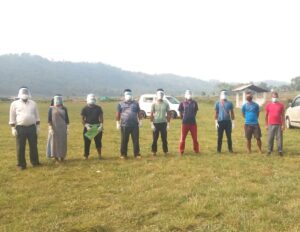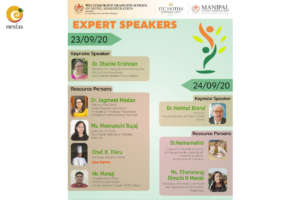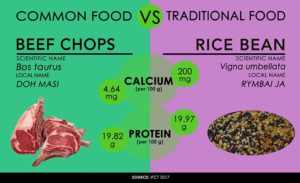In recent years, the Union Government has been giving increasing attention to nature friendly farming practices. The Prime Minister, Narendra Modi, himself during his 2022 Independence Day speech stressed on the potential of organic and natural farming to be an important pathway for making India Atmanirbhar (self-reliant) by cutting down cost on costly fertiliser imports. In fact, one of the tipping points for the Sri Lankan political crisis was the decision to ban import of chemical fertilizers in an attempt to address the depleting foreign reserves. However the sudden ban led to acute shortage of food grains and panic among the farmers. Ultimately, the crisis culminated in the fall of the Rajapaksa government.
The failure of the move notwithstanding there is an urgent need to transform the food system based on an industrial farming model which is responsible for more than 1/3rd of the global GHG emissions. Nature friendly farming practices are the need of the hour. The Indian Government understands this very well and has announced policies to strengthen the natural farming sector in the Country. It is in this context that on the 25th of August 2022, the Ministry of Agriculture and Farmers Welfare, Government of India, released the Guidelines of National Mission on Natural Farming. Although there are a lot of good things in the Guidelines, it is doubtful that the farmers in Meghalaya can avail the benefits outlined.
The Guidelines make a clear distinction between organic farming and natural farming, the gist being off-farm purchase of organic and biological inputs are allowed under the former while the focus in the latter is on using on-farm resources like biomass mulching, round the year green cover, indigenous cow-based dung and urine formulations. The Reserve Bank of India report on State-Wise per Hectare Consumption of Fertiliser (N+P+K) reported that fertilizer consumption in Meghalaya reduced from 14 kg per hectare in 2011-2012 to being nil in 2018-2019. The corresponding figures for India during the same period were 142 kg per hectare to 133 kg per hectare.
With the Government of Meghalaya lifting the ban on chemical fertilizers the numbers will go up (it will not be zero anymore) but most probably will still be lower than the national average. Since this particular move was taken keeping next year’s assembly elections in mind, hopefully it will be reversed thereafter. After all we don’t want to be going backwards when everyone is moving in the right direction for a change. Due to the low fertilizer consumption, based on the guidelines, farmers in Meghalaya are eligible to be included under the Natural Farming Systems category.
The Guidelines in fact does consider hilly states like Meghalaya to be important for the success of the Mission. Two type of areas have been accorded highest priority, viz., area falling under 5 km corridor on either side of River Ganga and rain-fed and traditionally low or no fertilizers using areas like the hilly, tribal, high forest land districts and remotely located districts. Meghalaya and the other states in the North East fall in the second category.
But while the intention is highly laudable, the guidelines enumerated in the document reveal a lack of understanding of the farming systems prevalent in Meghalaya. This oversight (I believe it is unintentional) will lead to majority of the farmers being excluded from the Mission which will be a big blow to the drive towards natural farming movement in the Country. An understanding of the farming systems practiced by the indigenous peoples of Meghalaya is therefore very crucial.
Traditionally, the local food system in Meghalaya is made up of four different farming systems. They are viz., jhum/shifting cultivation, bun/terrace farming, wet paddy cultivation and homestead gardening. Jhum is a rotational farming system which involves moving from one location to another every year. After a year of growing crops in one plot, it is abandoned to allow it to recuperate returning only after more than 7-10 years. Bun is a relatively more settled form of cultivation but also involves leaving the land fallow for five to six years after cultivating for two to three seasons. The remaining two systems, i.e., homestead gardening and wet paddy cultivation are settled form of farming systems where the farmer works on the same piece of land year after year. But while homestead gardening is practiced on small plots around the house, wet paddy is limited by availability of flat arable land. Jhum and bun therefore are very important farming systems for the farming community of Meghalaya. The implementation of the Guidelines of National Mission on Natural Farming in the State will completely ignore the famers who are practicing these systems. A look at certain sections in the Guidelines brings that out very clearly.
Section 10.2 (d) states that “States in consultation of local Gram Panchayat shall identify natural farming practitioners which are full time successful natural farmer with their entire land holding under natural farming since last 2-3 years”. Again section 10.4 (m) mentions that “besides day-to-day handholding by CF and CRPs, 12 training programme will be organized during crop growth period during the first two years to assess the progress, arrange interaction with experts and decide farm strategies.” The assessment of whether a system is following natural farming principles will involve soil testing and tracking of soil health for a period of over three-four years. In jhum and bun system, these guidelines become redundant as the land is abandoned after a year in the former and after two-three years in the latter, effectively keeping practitioners of both the systems, a large majority of the farmers, out of the purview of the Mission. The exclusion of the farmers will also lead to them losing out on the benefits of the certification system envisaged under the Mission.
As enumerated in section 6.1 one of the mission objectives is to “to create standards, certification procedure and branding for Natural Farming products for national and international markets.” This certification system according to section 10.4.5 will start from the 2nd year onwards. Farmers who get this certificate (in the future) will be able to demand premium prices which will help increase their household income and further incentivize them to continue with the system. Since a large majority of farmers in Meghalaya fall under the definition of natural farming this will boost rural income and push up demand in the economy leading to higher growth overall. But for this to happen, the Guidelines will have to be amended so that farmers in Meghalaya and the State in general do not lose out on the benefits that the Scheme will bring.
Recently, NESFAS (North East Slow Food and Agrobiodiversity Society) attended an online consultation called by National Coalition for Farming System to discuss the Guidelines. Similar issues were raised by other participants in light of their experience in working with the farming communities throughout the country. There has been no information that the Government of Meghalaya has intimated the Ministry of Agriculture and Farmers Welfare of the Union Government on the distinctiveness of farming systems in Meghalaya and how the Guidelines will lead to majority of farmers practicing these systems missing out on the benefits of the Mission. This will be a big loss not just to the farmers but to the State as well. Therefore it is very essential that the State Government discuss the Guidelines with all the stakeholders before they decide to roll out National Mission on Natural Farming in the State. The farming community of Meghalaya can play an important role in transforming the food system and help the State achieve the various Sustainable Development Goals. This will, however, not happen if they are left out of it or the State moves in the opposite direction.
This article was originally published in The Highland Post



